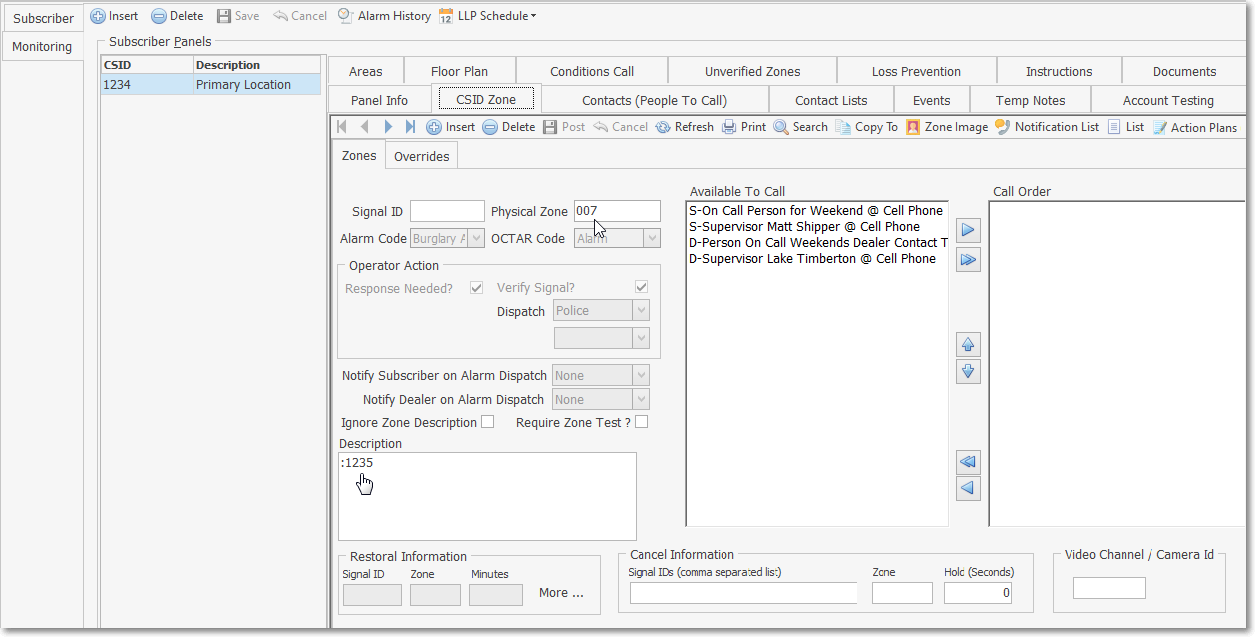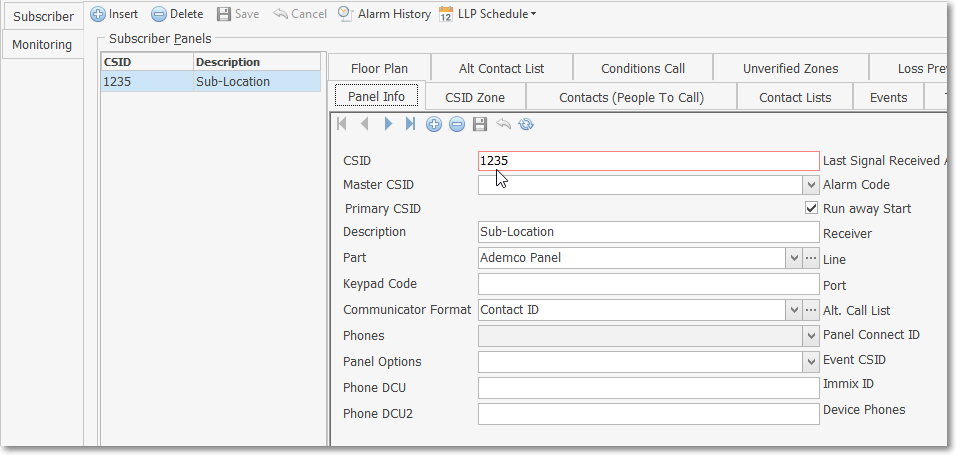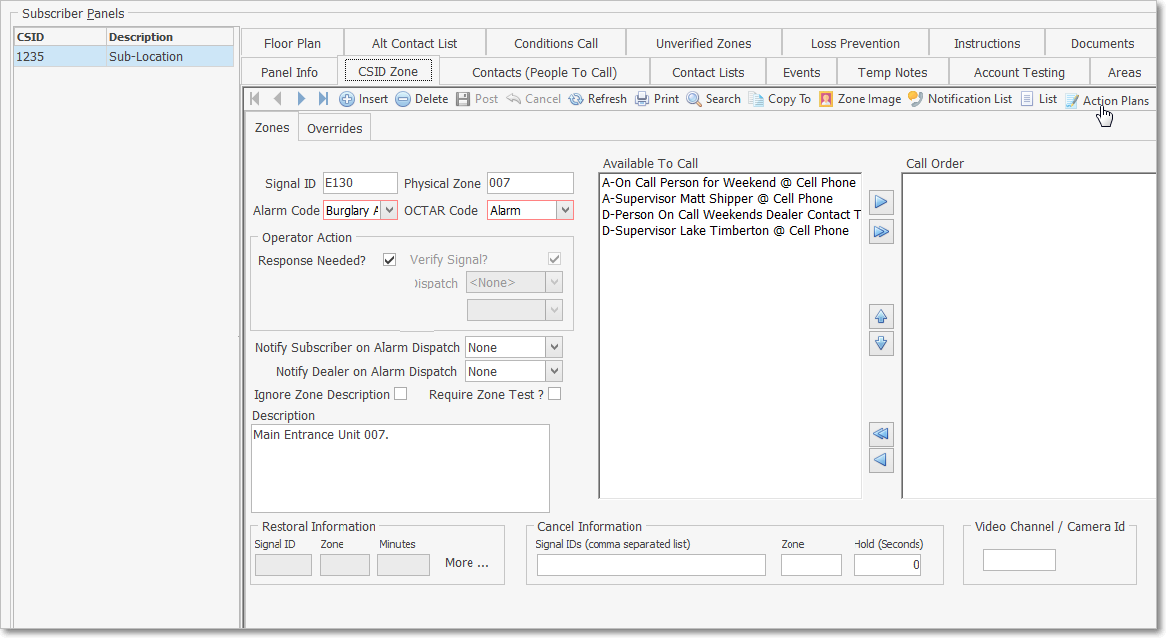❑The CSID Zone Redirection feature allows a Subscriber's CSID entered in the Subscriber Panel section - located below the Central Station Data section within the Monitoring Tab - to be translated (using special entries in the CSID Zones Form) into a series of separate and unique CSIDs - each of which are referred to below as a sub-location.
•These sub-locations do not exist as actual Control Panel transmitted CSIDs (e.g., ones programmed into a Subscriber's Control Panel), but instead exist as internally defined (User Defined) CSIDs which may then be monitored as separate and distinct sub-locations.
❑Why are these "sub-locations" needed? How would they be used?
•There are many times when individual units within: 1.) a strip shopping center, 2.) a small commercial office building occupied by multiple tenants, 3.) a flea market with many booths, 4.) an Assisted Living facility with dozens of apartments, etc., which are being protected with, and supervised by, a single Control Panel that can only be programmed with one Control Panel CSID (generally assigned by the monitoring service provider).
•Because each of these sub-locations actually represent a different Company, Family, or Individual, each sub-location must have a separate Subscriber record defined for each sub-location with:
a)Its own (in this case, internally created) CSID,
b)The actual Name and Address of the Company, Family, or Individual,
c)Their Password, Duress code, and PD & FD Permits Numbers (if required),
d)Their own set of CSID Zones, Supervised Events, Contacts (People To Call), False Alarm Tracking, Medical Information, etc.) .
❑How will it work? The Primary CSID of a Control Panel (the "Control Panel CSID") installed at a premises may have any number of Physical Zones defined - only limited by the actual number of Physical Zones which that Control Panel can report as discrete Areas (i.e., Partitions) within the protected premises.
•The CSID Zone Redirection feature allows some or all of these Physical Zones to be used to identify separate and distinct sections (sub-locations) of that premises, and recognize (identify) each with a unique CSID - a different one for each of these sub-locations.
✓Certain sets (each set being one or more) of these Physical Zones may be assigned to different businesses or residential units (sub-locations) within that premises, with each set of Physical Zones associated with those sub-locations using an internally created CSID.
✓When one of these Physical Zones - which has been associated with an internally created CSID - is transmitted by the Primary CSID of a Control Panel (the actual "Control Panel CSID"), that Physical Zone - along with the Signal ID received with it - is redirected to that internally created sub-location's CSID and is then interpreted by SPA employing the standard Signal Processing Order.
•Each of the internally created sub-location CSIDs must be defined as follows:
✓The Primary CSID of a Control Panel (the real "Control Panel CSID") is entered in the Subscriber Panels section and must be assigned a Communicator Format with Panel Zones that support a Signal ID (which properly identifies the reason for the signal); and support the use of Physical Zones (identifying the location of the signal) - such as the Contact ID or SIA Communicator Formats.
✓Within the CSID Zones Form associated with the Primary CSID of a Control Panel (the real "Control Panel CSID"):
▪Each Physical Zone (identifying the location of that signal) which is to be redirected to a sub-location CSID must be defined.

CSID Zone Redirection - Physical Zone 007 - CSID :1235
▪Each Physical Zone (identifying the location of that signal) must have the sub-location's Redirection CSID defined in the Description field, preceded with a colon (e.g., ":1235").
▪This will be the internally created sub-location's CSID.
•For each sub-location Redirection CSID, another separate Subscriber record must be created with the appropriate Name and Address, and related Contact Information.
✓The Central Station Data and Subscriber Panel information for the internally created sub-location's CSID must also be defined for this sub-location Subscriber.

▪The Subscriber Panel for the sub-location CSID must be assigned the same Communicator Format as the Primary CSID of the Control Panel (the real "Control Panel CSID").
✓Individual CSID Zone record(s) must have the Physical Zone(s) defined that will be redirected to that specific sub-location CSID. (e.g., if Physical Zones "007" and "008" are actually reporting a sub-location, there must be two CSID Zone records created - one with Physical Zone "007" and one with Physical Zone "008" ) and each should include a Description of that specific Physical Zone.
✓Certain Signal IDs may also need to be defined:
▪When the assigned Communicator Format has Signal IDs defined in its associated Panels Zones Form, and these Signal IDs properly represent what these Alarm Signals and Events represent, and how they are to be processed, no further data entry is necessary.

CSID Zone Form - Signal ID & Physical Zone entered - Action Plan selected
▪However, if one or more Signal IDs for a sub-location Redirection CSID requires special handling (e.g., a different Operator Guided Response or Action Plan, or a different Alarm Signal or Event, Description, or Alarm Condition Code) than what is predefined in the Panels Zones Form of its Communicator Format), those Signal ID and Physical Zone combinations must be specifically defined as CSID Zones for that sub-location (Redirection) CSID.
oTo assign an Action Plan to this Redirection CSID, Select the Action Plans Icon on the CSID Zones tab's Ribbon Menu
i.Choose that Action Plan for processing this "Redirection CSID" Alarm Signal.
a.Select the Action Plans option on the CSID Zones tab's Ribbon Menu (see the Hand Pointer in the illustration above) to display the Actions Plans For: dialog
b.Click the ![]() Insert Icon on the Actions Plans For: dialog's Ribbon Menu
Insert Icon on the Actions Plans For: dialog's Ribbon Menu
c.Action Plan - Use the Drop-Down Selection List to Choose the appropriate Automated System Action Plan for processing this Alarm Signal.
d.Active - By default, this field will be Checked
e.Description - Enter a brief description for this Action Plan entry
f. Click the ![]() Post Icon to record this Action Plan entry
Post Icon to record this Action Plan entry
g.The selected Action Plan will be used to manage the processing of this FR* entry.
✓In addition to the CSID Zones requirements outlined immediately above, records for Events, Contacts (People To Call), Account Testing, Medical Information, Holidays , etc., should also be defined, as needed, for each sub-location CSID.
•The net result is that the Primary CSID of a Control Panel (the "Control Panel CSID"), and all the internally created sub-location CSIDs, may individually report any type of Alarm Signal, and be individually supervised with any number of Opening and Closing Events and Tests.
✓Therefore any of the CSIDs - were created for these sub-locations - will display to the Operator their own specific Name and Address (and suite number, office number, or store name, etc.) and related Contact Information, and the Central Station Data related (Password, Supervised Events, Contacts (People To Call), False Alarm Tracking, etc.) information as well as the assigned Operator Guided Response or Action Plan.
❑A "sub-location" Summary (example):
•A Control Panel is providing protection for itself (the Primary Subscriber CSID) and three other stores (the sub-locations) in a four store strip shopping center.
✓The Physical Zones being reported by that Control Panel are 01, 02, 03, and 04 - representing the four stores that are being monitored.
✓These are defined in the CSID Zones table for the Primary Subscriber CSID.
•Defining the "sub-locations":
✓In the CSID Zone Form, the Physical Zones (01, 02, 03, and 04) are defined.
▪The Physical Zone 01 is really the Primary Subscriber and so when defining it in the CSID Zones table, it's Description will be an appropriate entry describing to the actual location and/or situation being reported.
▪The other three Physical Zones will have a very different type of Description which will be, in this example, the sub-location's Redirection CSIDs of ":1235", ":1236", and ":1237" representing the CSIDs (the sub-locations) for the other three stores.
✓These other three stores will also have three separate Subscriber records entered, one for each of these sub-locations,
▪The Central Station Data section will be completed for each Subscriber record with the appropriate Subscriber Panel CSID (1235, 1236, or 1237), each defined with the same Communicator Format assigned, which must also be the Communicator Format assigned to the Primary Subscriber CSID.
▪Any number of CSID Zones per sub-location may be defined, each containing just the Physical Zone(s) that will be redirected to the sub-location, and a real Description relating to the actual location or situation being reported.
▪If any of these sub-locations require special handling instructions, CSID Zones with both Signal ID and Physical Zone information will need to be created
✓When the Control Panel sends a Signal, it will send a Physical Zone identifying the location of that signal, and a Signal ID identifying the reason for that signal.
▪If no Redirection CSID has been defined, the Signal will be interpreted by SPA employing the standard Signal Processing Order.
▪If there is a Redirection CSID defined in the CSID Zones Form containing that Physical Zone:
oThe Physical Zone and Redirection CSID identifying the sub-location CSID is used, along with:
oThe Signal ID received - which will have been defined in either the CSID Zones Form for the sub-location or in the Panels Zones Form for the assigned Communicator Format.
oThus the combination of the 1.) Redirection CSID, 2.) Physical Zone, and 3.) appropriate Signal ID, will be interpreted by SPA employing the standard Signal Processing Order.
✓In either case, the appropriate Subscriber CSID information will be used.
❖SPA and the Signal Processing Form within MKMSCS will follow the Operator Guided Response or Action Plan defined in the CSID Zones table of the appropriate Subscriber CSID and use the Events, Contacts (People To Call), Account Testing, Medical Information, and Holidays defined for that Subscriber CSID to interpret and display the Alarm Signal.